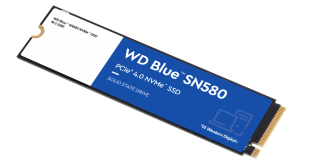Having worked for the data storage company for more than 20 years, Western Digital’s Vice President of EMEAI Sales outlines what advancements we can expect to see in the storage arena in the next few years, and how WD’s portfolio of technologies and solutions have evolved.
Tell us a bit about your role at Western Digital.
I am responsible for the EMEAI (Europe, Middle East, Africa, and India) sales region for Western Digital. I look after all business segments covering distribution, OEM, and consumer sales for all products and segments.
This requires a great deal of travel across our regions, and I believe we have the industry’s best distribution network of partners covering our total portfolio of products. I have worked for Western Digital for over 20 years, having lived and worked in various countries during this time.
What interesting projects are your team working on at the moment?
We cannot reveal any specific customer “projects” we are working on with our partners, as these are confidential. However, beyond traditional applications, we are seeing our products being used in an ever- increasing IoT marketplace from edge to core across many verticals applications and use cases, from kettles, door bells, cash registers, autonomous cars, mobile phones, the list goes on.
What new advancements in the storage arena can we expect to see in the coming years?
NVMe and NVMe over Fabric are going to be important over the coming year. There is a growing need to alter the flexibility of data infrastructure without physically touching it. In 2019, we will see open composability – versus today’s inflexible, proprietary solutions – come of age and start to go mainstream as organisations look to build composable infrastructures on open standards to allow for specialised configurations that are specific to their workloads and address diverse data.
We believe this is how a lot of infrastructure is going to be deployed going forward. Our OpenFlex product line and architecture is a leading example of this in the industry.
HDDs using Energy Assist technology will begin to emerge as customers seek higher capacities, at lower costs, for their data centres. Organisations will need more storage space, but current HDD technology is approaching limits for capacity, therefore, we are looking to new Energy Assist technologies to deliver a cost- effective solution.
We believe this can be achieved via MAMR. We will also be launching our 16TB hard drive this year with Energy Assist technology. We expect it will ramp up to 20+TB HDDs by 2020 and beyond.
Driven by IoT, there is a rise in endpoints which generate their own data at scale. A great example is autonomous cars, which can generate up to 4TBs of data per day. Regardless of use cases or how many IoT devices are unleashed, their success hinges on one critical component – the speed of compute.
Compute power is getting closer to the data produced by the devices, allowing it to be processed in real-time, and for devices to awaken and realise their full potential. Today, we have a full portfolio of solutions which can handle the velocity and volume of data being created by these new endpoints.
Western Digital has evolved quite a bit in the past few years. How have your various offerings changed and expanded?
Western Digital has evolved and moved from a components HDD manufacturer to a data technology company. Today, we have a full portfolio, offering the breadth and depth of technologies and solutions from NAND to petabyte-scale object-storage systems. Our exceptionally broad storage portfolio addresses diverse needs, markets and applications – from consumers to hyperscale data centre customers, and for uses cases from smartphones to multi-petabyte data centre archival systems.
Last year we were recognised as a Visionary in the 2018 Gartner Magic Quadrant for Solid-State Arrays for the fourth year in a row. We were also named a Challenger in Gartner’s 2018 Magic Quadrant for Distributed File Systems and Object Storage. These are just two examples of our continued momentum in our growing Data Center Systems business unit.
One unique factor that many don’t know about is our unique ability to optimise from silicon to systems. This is called our “Symbiotics Design” approach that enables innovation and optimisation across multiple technologies and software, and hardware design points – from silicon to devices to systems. This allows us to fine-tune the stack and deliver breakthrough value for a full range of data-centric applications.
All of these products are sold through Western Digital’s distribution channel.
What are Western Digital’s plans for the year ahead and are there any products and advancements we should keep an eye out for?
We are always innovating across all our product lines and brands, as well as focusing on new value-add market segments and initiatives. For example, last year at the RISC-V Summit we announced our SweRV Core and a new cache coherency fabric initiative.
These contributions and innovations are expected to accelerate development of new open, purpose-built compute architectures for Big Data and Fast Data environments. Western Digital has taken an active role in helping to advance the RISC-V ecosystem, including multiple related strategic investments and partnerships, and committed to its goal of transitioning one billion of the company’s processor cores to the RISC-V architecture.
We also have a strong focus on the OpenFlex architecture and product line. It is built on industry- standard NVMe technology and creates independently scalable pools of flash and disks that can be connected to computing resources via common networking technologies, such as Ethernet.
The reason behind this is that the ‘one size fits all’ approach is no longer effective for data-intensive workloads (e.g. big data, fast data, analytics, artificial intelligence and machine learning). What is required are capabilities that enable more control over the blend of resources that each need so that optimised levels of processing, storage and network bandwidth can be scaled independent of one another.
The end objective is a flexible and composable infrastructure. Such flexibility will minimise complexities around Big Data and how it is being captured, preserved, accessed and transformed.
—
Like this content? Sign up for the free PCR Daily Digest email service to get the latest tech news straight to your inbox. You can also follow PCR on Twitter and Facebook.
—
The PCR Awards 2019 take place on 6th March at The Brewery, London. Buy your tickets here.
 PCR Tech and IT retail, distribution and vendor news
PCR Tech and IT retail, distribution and vendor news




